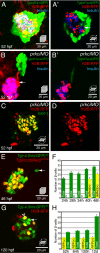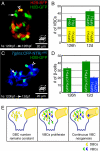Distinct populations of quiescent and proliferative pancreatic beta-cells identified by HOTcre mediated labeling
- PMID: 19706417
- PMCID: PMC2736433
- DOI: 10.1073/pnas.0906348106
Distinct populations of quiescent and proliferative pancreatic beta-cells identified by HOTcre mediated labeling
Abstract
Pancreatic beta-cells are critical regulators of glucose homeostasis, and they vary dramatically in their glucose stimulated metabolic response and levels of insulin secretion. It is unclear whether these parameters are influenced by the developmental origin of individual beta-cells. Using HOTcre, a Cre-based genetic switch that uses heat-induction to precisely control the temporal expression of transgenes, we labeled two populations of beta-cells within the developing zebrafish pancreas. These populations originate in distinct pancreatic buds and exhibit gene expression profiles suggesting distinct functions during development. We find that the dorsal bud derived beta-cells are quiescent and exhibit a marked decrease in insulin expression postembryonically. In contrast, ventral bud derived beta-cells proliferate actively, and maintain high levels of insulin expression compared with dorsal bud derived beta-cells. Therapeutic strategies to regulate beta-cell proliferation and function are required to cure pathological states that result from excessive beta-cell proliferation (e.g., insulinoma) or insufficient beta-cell mass (e.g., diabetes mellitus). Our data reveal the existence of distinct populations of beta-cells in vivo and should help develop better strategies to regulate beta-cell differentiation and proliferation.
Conflict of interest statement
The authors declare no conflict of interest.
Figures





References
-
- Dor Y, Brown J, Martinez OI, Melton DA. Adult pancreatic beta-cells are formed by self-duplication rather than stem-cell differentiation. Nature. 2004;429:41–46. - PubMed
-
- Russ HA, Bar Y, Ravassard P, Efrat S. In vitro proliferation of cells derived from adult human beta-cells revealed by cell-lineage tracing. Diabetes. 2008;57:1575–1583. - PubMed
-
- Xu X, et al. Beta cells can be generated from endogenous progenitors in injured adult mouse pancreas. Cell. 2008;132:197–207. - PubMed
-
- Wessells NK, Cohen JH. Early Pancreas Organogenesis: Morphogenesis, Tissue Interactions, and Mass Effects. Dev Biol. 1967;15:237–270. - PubMed
Publication types
MeSH terms
Substances
Grants and funding
LinkOut - more resources
Full Text Sources
Other Literature Sources
Molecular Biology Databases
Research Materials

